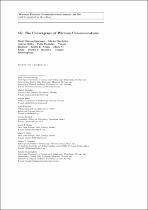JavaScript is disabled for your browser. Some features of this site may not work without it.
- ResearchSpace
- →
- Research Publications/Outputs
- →
- Journal Articles
- →
- View Item
| dc.contributor.author |
Chavez-Santiago, R

|
|
| dc.contributor.author |
Szydelko, M

|
|
| dc.contributor.author |
Kliks, A

|
|
| dc.contributor.author |
Foukalas, F

|
|
| dc.contributor.author |
Haddad, Y

|
|
| dc.contributor.author |
Nolan, KE

|
|
| dc.contributor.author |
Kelly, MY

|
|
| dc.contributor.author |
Masonta, Moshe T

|
|
| dc.contributor.author |
Balasingham, I

|
|
| dc.date.accessioned | 2015-10-30T09:46:10Z | |
| dc.date.available | 2015-10-30T09:46:10Z | |
| dc.date.issued | 2015-03 | |
| dc.identifier.citation | Chavez-Santiago, R, Szydelko, M, Kliks, A, Foukalas, F, Haddad, Y, Nolan, KE, Kelly, MY, Masonta, MT and Balasingham, I. 2015. 5G: the convergence of wireless communications. Wireless Personal Communications, vol. 83(3), pp. 1617-1642 | en_US |
| dc.identifier.issn | 0929-6212 | |
| dc.identifier.uri | http://link.springer.com/article/10.1007%2Fs11277-015-2467-2#/page-1 | |
| dc.identifier.uri | http://hdl.handle.net/10204/8220 | |
| dc.description | Copyright: 2015. Springerlink. This is a post-print version. The definitive version of the work is published in Wireless Personal Communications | en_US |
| dc.description.abstract | As the rollout of 4G mobile communication networks takes place, representatives of industry and academia have started to look into the technological developments toward the next generation (5G). Several research projects involving key international mobile network operators, infrastructure manufacturers, and academic institutions, have been launched recently to set the technological foundations of 5G. However, the architecture of future 5G systems, their performance, and mobile services to be provided have not been clearly defined. In this paper, we put forth the vision for 5G as the convergence of evolved versions of current cellular networks with other complementary radio access technologies. Therefore, 5G may not be a single radio access interface but rather a ”network of networks”. Evidently, the seamless integration of a variety of air interfaces, protocols, and frequency bands, requires paradigm shifts in the way networks cooperate and complement each other to deliver data rates of several Gigabits per second with end-to-end latency of a few milliseconds. We provide an overview of the key radio technologies that will play a key role in the realization of this vision for the next generation of mobile communication networks. We also introduce some of the research challenges that need to be addressed. | en_US |
| dc.language.iso | en | en_US |
| dc.publisher | Springerlink | en_US |
| dc.relation.ispartofseries | Workflow;14583 | |
| dc.subject | Wireless communications | en_US |
| dc.subject | International mobile network operators | en_US |
| dc.subject | 5G mobile communication networks | en_US |
| dc.subject | Radio spectrum | en_US |
| dc.subject | Traffic offloading | en_US |
| dc.subject | Small-cells | en_US |
| dc.subject | Software defined radio | en_US |
| dc.subject | Software defined networking | en_US |
| dc.title | 5G: the convergence of wireless communications | en_US |
| dc.type | Article | en_US |
| dc.identifier.apacitation | Chavez-Santiago, R., Szydelko, M., Kliks, A., Foukalas, F., Haddad, Y., Nolan, K., ... Balasingham, I. (2015). 5G: the convergence of wireless communications. http://hdl.handle.net/10204/8220 | en_ZA |
| dc.identifier.chicagocitation | Chavez-Santiago, R, M Szydelko, A Kliks, F Foukalas, Y Haddad, KE Nolan, MY Kelly, Moshe T Masonta, and I Balasingham "5G: the convergence of wireless communications." (2015) http://hdl.handle.net/10204/8220 | en_ZA |
| dc.identifier.vancouvercitation | Chavez-Santiago R, Szydelko M, Kliks A, Foukalas F, Haddad Y, Nolan K, et al. 5G: the convergence of wireless communications. 2015; http://hdl.handle.net/10204/8220. | en_ZA |
| dc.identifier.ris | TY - Article AU - Chavez-Santiago, R AU - Szydelko, M AU - Kliks, A AU - Foukalas, F AU - Haddad, Y AU - Nolan, KE AU - Kelly, MY AU - Masonta, Moshe T AU - Balasingham, I AB - As the rollout of 4G mobile communication networks takes place, representatives of industry and academia have started to look into the technological developments toward the next generation (5G). Several research projects involving key international mobile network operators, infrastructure manufacturers, and academic institutions, have been launched recently to set the technological foundations of 5G. However, the architecture of future 5G systems, their performance, and mobile services to be provided have not been clearly defined. In this paper, we put forth the vision for 5G as the convergence of evolved versions of current cellular networks with other complementary radio access technologies. Therefore, 5G may not be a single radio access interface but rather a ”network of networks”. Evidently, the seamless integration of a variety of air interfaces, protocols, and frequency bands, requires paradigm shifts in the way networks cooperate and complement each other to deliver data rates of several Gigabits per second with end-to-end latency of a few milliseconds. We provide an overview of the key radio technologies that will play a key role in the realization of this vision for the next generation of mobile communication networks. We also introduce some of the research challenges that need to be addressed. DA - 2015-03 DB - ResearchSpace DP - CSIR KW - Wireless communications KW - International mobile network operators KW - 5G mobile communication networks KW - Radio spectrum KW - Traffic offloading KW - Small-cells KW - Software defined radio KW - Software defined networking LK - https://researchspace.csir.co.za PY - 2015 SM - 0929-6212 T1 - 5G: the convergence of wireless communications TI - 5G: the convergence of wireless communications UR - http://hdl.handle.net/10204/8220 ER - | en_ZA |






